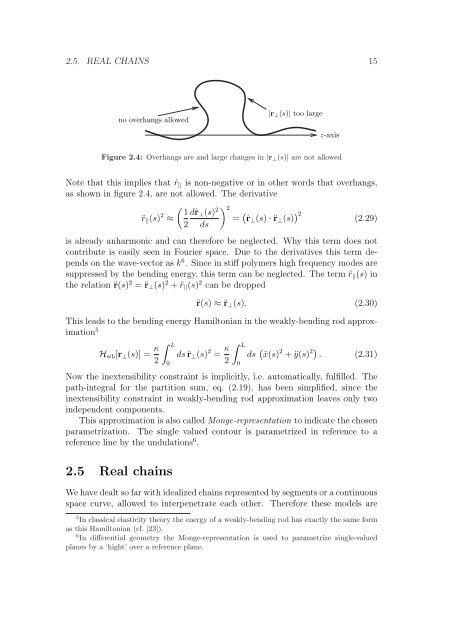Polymers in Confined Geometry.pdf
Polymers in Confined Geometry.pdf
Polymers in Confined Geometry.pdf
Create successful ePaper yourself
Turn your PDF publications into a flip-book with our unique Google optimized e-Paper software.
2.5. REAL CHAINS 15<br />
no overhangs allowed<br />
|r⊥(s)| too large<br />
z-axis<br />
Figure 2.4: Overhangs are and large changes <strong>in</strong> |r⊥(s)| are not allowed<br />
Note that this implies that ˙r|| is non-negative or <strong>in</strong> other words that overhangs,<br />
as shown <strong>in</strong> figure 2.4, are not allowed. The derivative<br />
¨r||(s) 2 <br />
1 d˙r⊥(s)<br />
≈<br />
2<br />
2 2 =<br />
ds<br />
˙r⊥(s) · ¨r⊥(s) 2 (2.29)<br />
is already anharmonic and can therefore be neglected. Why this term does not<br />
contribute is easily seen <strong>in</strong> Fourier space. Due to the derivatives this term depends<br />
on the wave-vector as k 6 . S<strong>in</strong>ce <strong>in</strong> stiff polymers high frequency modes are<br />
suppressed by the bend<strong>in</strong>g energy, this term can be neglected. The term ¨r||(s) <strong>in</strong><br />
the relation ¨r(s) 2 = ¨r⊥(s) 2 + ¨r||(s) 2 can be dropped<br />
¨r(s) ≈ ¨r⊥(s). (2.30)<br />
This leads to the bend<strong>in</strong>g energy Hamiltonian <strong>in</strong> the weakly-bend<strong>in</strong>g rod approximation5<br />
Hwb[r⊥(s)] = κ<br />
2<br />
L<br />
0<br />
ds ¨r⊥(s) 2 = κ<br />
2<br />
L<br />
0<br />
ds ¨x(s) 2 + ¨y(s) 2 . (2.31)<br />
Now the <strong>in</strong>extensibility constra<strong>in</strong>t is implicitly, i.e. automatically, fulfilled. The<br />
path-<strong>in</strong>tegral for the partition sum, eq. (2.19), has been simplified, s<strong>in</strong>ce the<br />
<strong>in</strong>extensibility constra<strong>in</strong>t <strong>in</strong> weakly-bend<strong>in</strong>g rod approximation leaves only two<br />
<strong>in</strong>dependent components.<br />
This approximation is also called Monge-representation to <strong>in</strong>dicate the chosen<br />
parametrization. The s<strong>in</strong>gle valued contour is parametrized <strong>in</strong> reference to a<br />
reference l<strong>in</strong>e by the undulations 6 .<br />
2.5 Real cha<strong>in</strong>s<br />
We have dealt so far with idealized cha<strong>in</strong>s represented by segments or a cont<strong>in</strong>uous<br />
space curve, allowed to <strong>in</strong>terpenetrate each other. Therefore these models are<br />
5In classical elasticity theory the energy of a weakly-bend<strong>in</strong>g rod has exactly the same form<br />
as this Hamiltonian (cf. [23]).<br />
6In differential geometry the Monge-representation is used to parametrize s<strong>in</strong>gle-valued<br />
planes by a ‘hight’ over a reference plane.













